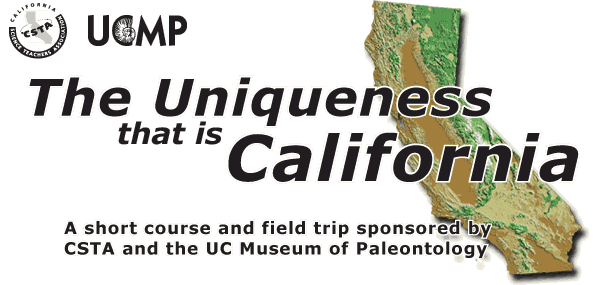9:00–9:10
9:10–10:00
|
Welcome and Logistics
The Big Squeeze: The Topographic Evolution of the San Francisco
Bay Region
David
Howell, US Geological Survey, Menlo Park
The bedrock that forms the underpinnings of the San Francisco Bay regions
evinces a complex history spanning 140 million years. However, the topography
that we know today is quite young, generally less than two million years
old. A small component of east-west compression associated with the San
Andreas fault system is responsible for the uplift of mountains and the
downward warping of valleys. Further sculpting is the result of gravity
where massive chunks of rock have slid to lower elevations.
|
| 10:10–11:00 |
Aquatic Reptiles to Saber-toothed Cats: Evolution
of California’s Vertebrate Faunas
Bill
Clemens, Interim Director, UC Museum of Paleontology
Assembling California was a long-term process. Until about 100 million
years ago the Pacific Ocean, inhabited by a diverse fauna of aquatic vertebrates,
covered most of what is now California. During the last 60 million years
a more complete fossil record documents changes from tropical forests,
inhabited by primitive primates and small relatives of modern horses, to
the rigors of the Ice Age when California’s landscape was dotted by herds
of mammoths and camels stalked by the occasional saber-toothed cat. |
| 11:15–12:05 |
Indians, Missionaries, and Merchants: The Archaeology
of the Greater San Francisco Bay
Kent
Lightfoot, Department of Anthropology, UC Berkeley
California is truly unique: it was here that colonial empires of Imperial Spain
and Tsarist Russia first touched on the Pacific Coast. Caught within and between
the Russian and Spanish colonies were hundreds of communities of coastal hunter-gatherers
whose entanglements with the foreigners laid the foundation for our multi-ethnic
state. Recent archaeological investigations have unearthed many new findings
about the cultural encounters that took place during the late 1700s and 1800s.
|
12:05–1:10
1:10–2:00
|
Break for Lunch
Relicts and Radiations: Rise of the California Flora
Bruce
Baldwin, Jepson and University Herbaria, UC Berkeley
California’s flora is famous among botanists worldwide for its unique
composition, extraordinary richness, and well-studied evolutionary examples.
Climatic stability, upheaval, and isolation all played roles in shaping
our native plant life to resemble an oceanic-island assemblage. Recent
studies have begun to reveal another, finer layer of plant diversity
that offers new perspectives on how our flora arose.
|
| 2:10–3:00 |
Genes and Geologic Process on the California Coast:
Connecting Antarctica to California
David
Jacobs, Department of Biology, UC Los Angeles
California has a diverse temperate marine fauna. Molecular data connects that
diversification with the start of upwelling along the coast that began about
15 million years ago, triggered by the cooling of the South Pole and Southern
Ocean. Such is the nature of our globally-connected world that California diversity
has its origin in Antarctic climate change! |
| 3:10–4:00 |
California’s Coast Redwood and the Land-Sea Connection
Todd
Dawson, Integrative Biology, UC Berkeley
California’s State Tree, the coast redwood, is the tallest on Earth and
sustains some of the highest growth rates ever measured in a conifer.
How is this possible in a Mediterranean climate characterized by summer
drought? One answer lies in understanding the unique coastal climate
of California and the connection between near-shore redwood forests,
the Pacific Ocean and the resources it can provide, and the biology of
our State Tree.
Please note: Regretfully, Dr. Dawson was unable to participate
in the short course. In his place, Dr. David Lindberg kindly
stepped in and added to our program by speaking on
his
research
to determine the evolutionary relationships among groups of limpets.
Interestingly, his recent molecular work on California limpets
has not only
produced a phylogeny, but has also provided a methodology for
identifying patterns in the movement of a group of warm-water
limpets. This has significance in that changes in their distribution
can
provide
a signal of changes in water temperature and changing climate
patterns at a more global level. |
|
|
SUNDAY FIELD TRIP: Click here for photos
from our Sunday adventures.
This year we offered a Sunday field trip for those who would like to
personally experience the geology and oenology of the Napa Valley.
Departing from the
UC campus at 9:00 am, our exploration began at the lookout platform of
Opus One winery, in the heart of Napa Valley. We observed the critical
features
of the valley, including giant landslides, and sampled some Napa nectar.
From Opus One we traveled by bus, visiting several bedrock outcrops,
reading some
of the 140-million-year history of the Valley. Then we went to the vineyards
at Stag’s Leap Wine Cellars to examine soils and vines. We ended the day
in the SLWC cave, cut into the neck of an ancient volcano, and while there,
sampled
an array of wines. We returned to campus shortly after 5:00 pm.
|
